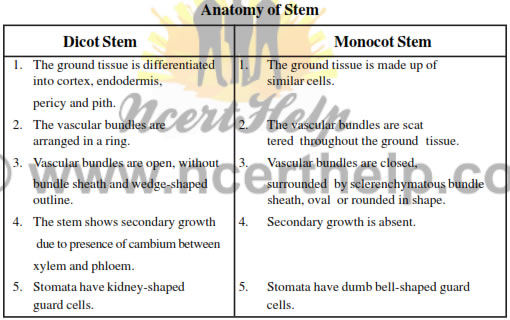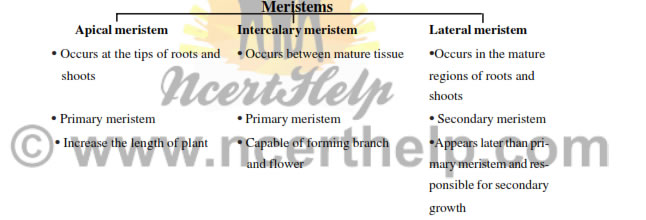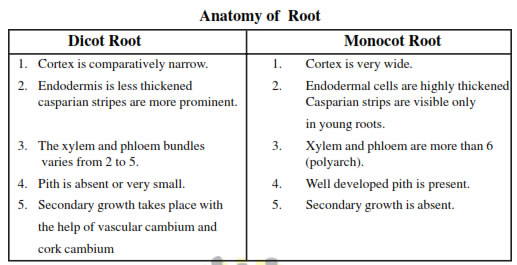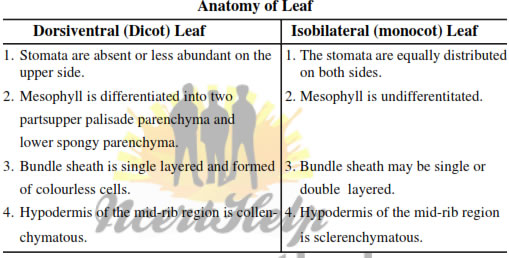Anatomy Of Flowering Plants : Chapter Notes - Class 11 Biology
Anatomy : Anatomy is the study of internal structure of organisms. Plant anatomy includes organisation and structure of tissues.
Tissue : A group of similar cells alongwith intercellular substance which perform a specific function.
Meristematic tissues : The meristematic tissue is made up of the cells which have the capability to divide. Meristems in plants are restricted to a specialised regions and responsible to the growth of plants.
Axillary bud : The buds which are present in the axils of leaves and are responsible for forming branches or flowers.
Permanent tissues : The permanent tissues are derived from meristematic tissue and are composed of cells, which have lost the ability to divide.
Types of Permanent Tissue
Simple Complex
Parenchyma Collenchyma Sclerenchyma Xylem Phloem
Parenchyma : Thin walled cells, with intercellular spaces, cell wall is made up of cellulose. It performs the function like photosynthesis, storage, secretion.
Collenchyma : It is formed of living, closely packed isodimetric cells. It’s cells are thickened at the corners due to deposition of cellulose and pectin. It provides mechanic support to the growing parts of the plant.
Sclerenchyma : It is formed of dead cells with thick and lignified walls.
They have two types of cells : fibres and sclereids.
Xylem : Xylem consists of tracheids, vessels, xylem fibres and xylem pa- renchyma. It conducts water and minerals from roots to other parts of plant.
Protoxylem : The first formed primary xylem elements.
Metaxylem : The later formed primary xylem.
Endarch : Protoxylem lies towards the centre and metaxylem towards the periphery of the organ.
Phloem : Phloem consists of sieve tube elements, companion cells, phloem fibres and phloem parenchyma. Phloem transports the food material from leaves to various parts of the plant.
Protophloem : First formed phloem with narrow sieve tubes.
Metaxylem : Later formed phloem with bigger sieve tubes.
The Tissue System :
- Epidermal tissue system : It includes cuticle, epidermis, epidermal hairs, root hairs, trichomes and stomata.
- The ground tissue system : It is made up of parenchyma, collenchyma, sclerenchyma. In dicot stems and roots the ground tissue is divided into hypodermis cortex, endodermis, pericycle, medullary rays and pith.
- The vascular tissue system : It includes vascular bundles which are made up of xylem and phloem.
Vascular Bundles
Radial bundles Conjoint bundles (Xylem and phloem occur (Xylem and phloem are situated at on different radii) the same radius of vascular bundle)
Collateral bundles Bicolateral bundles Concentric bundles Open Closed
(with cambium) (without cambium)
Secondary growth in dicot stem : An increase in the girth (diameter) in plants. Vascular cambium and cork cambium (lateral meristems) are involved in secondary growth.
- Formation of cambial ring : Intrafascicular cambium + interfascicular cambium.
- Formation of secondary xylem and secondary phloem from cambial ring.
- Formation of spring wood and autumn wood.

- Development of cork cambium (phellogen)
Cork Cambium Cork (phellem) - From outer cells
Sec. cortex (phelloderm) - From inner cells
(Phellogen + Phellem + Phelloderm) = Periderm
Secondary growth in dicot roots : Secondary growth in dicot root occurs with the activity of secondary meristems (vascular cambium). This cambium is produced in the stele and cortex, and results in increasing the girth of dicot roots.







No comments:
Post a Comment